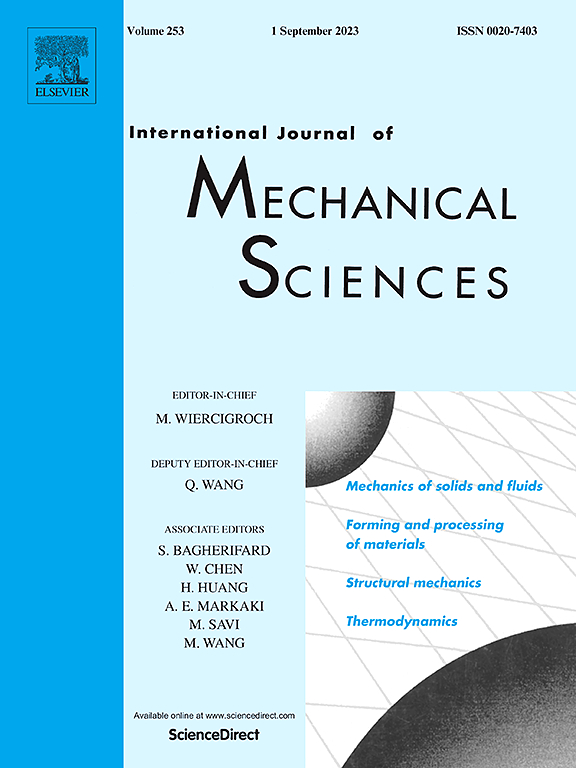Missing critical mass ratio in VIV of rigidly connected cylinders
IF 7.1
1区 工程技术
Q1 ENGINEERING, MECHANICAL
International Journal of Mechanical Sciences
Pub Date : 2025-04-20
DOI:10.1016/j.ijmecsci.2025.110236
引用次数: 0
Abstract
Two-dimensional numerical study is carried out for two rigidly coupled cylinders in tandem arrangement undergoing the transverse vortex-induced vibration (VIV) at low Reynolds numbers of , 100, 150 and 200. A fixed center-to-center spacing ratio of is selected. Results are examined over the reduced velocity range of and low mass ratios () are considered. This study reveals several distinct features that differ significantly from single cylinder VIV. First, contrary to single cylinder cases where a critical mass ratio exists, no critical mass ratio is observed in the tandem system at and the amplitude response increases smoothly with decreasing mass ratio. Second, decreasing mass ratio leads to enhanced soft lock-in behavior with frequency ratios progressively decreasing below unity while triggering earlier and more rapid amplitude growth. The lock-in bandwidth also shows an unexpected trend by narrowing with decreasing mass ratio in the extremely low mass ratio regime (), which is opposite to the widening trend observed in systems with . Third, a distinctive quasi-periodic response characterized by beating phenomena appears in the lower branch (). Detailed force decomposition reveals pressure forces dominate over viscous forces with pressure lift coefficients of the upstream and downstream cylinders. It is the phase differences between two cylinders that leads to the quasi-periodic behavior. Moreover, Dynamic mode decomposition analysis shows this quasi-periodicity results from vortex impingement on the downstream cylinder. These findings offer new insights into the complex fluid–structure interactions in tandem cylinder arrangements at extremely low mass ratios, with practical implications for engineering applications such as the design of twin-tube submerged floating tunnels.

刚性连接圆柱涡激振动中缺少临界质量比
对低雷诺数Re=60、100、150和200时刚性耦合圆柱串列振动进行了二维数值研究。选择固定的中心间距比s/D=2。在Ur=0.25−100的减速速度范围内检查结果,并考虑低质量比(0.02≥m *≥1)。这项研究揭示了几个明显不同于单缸VIV的特征。首先,与存在临界质量比的单缸情况相反,串联系统在s/D=2时不存在临界质量比,振幅响应随着质量比的减小而平稳增加。其次,质量比的减小导致软锁相行为的增强,频率比在小于1时逐渐减小,同时触发更早、更快的振幅增长。在极低质量比区(m∗≥1),锁相带宽随质量比的减小而变窄,这与在m∗>;1的系统中观察到的变宽趋势相反。其三,下分支出现以跳动现象为特征的独特准周期响应(Ur=2.5 ~ 4.25)。详细的力分解表明,压力力占主导地位的粘性力与压力升系数的上下游气缸。两个圆柱体之间的相位差导致了准周期行为。动态模态分解分析表明,这种准周期性是旋涡对下游气缸撞击的结果。这些发现为极低质量比下串联圆柱结构的复杂流固相互作用提供了新的见解,对工程应用具有实际意义,例如双管水下浮式隧道的设计。
本文章由计算机程序翻译,如有差异,请以英文原文为准。
求助全文
约1分钟内获得全文
求助全文
来源期刊

International Journal of Mechanical Sciences
工程技术-工程:机械
CiteScore
12.80
自引率
17.80%
发文量
769
审稿时长
19 days
期刊介绍:
The International Journal of Mechanical Sciences (IJMS) serves as a global platform for the publication and dissemination of original research that contributes to a deeper scientific understanding of the fundamental disciplines within mechanical, civil, and material engineering.
The primary focus of IJMS is to showcase innovative and ground-breaking work that utilizes analytical and computational modeling techniques, such as Finite Element Method (FEM), Boundary Element Method (BEM), and mesh-free methods, among others. These modeling methods are applied to diverse fields including rigid-body mechanics (e.g., dynamics, vibration, stability), structural mechanics, metal forming, advanced materials (e.g., metals, composites, cellular, smart) behavior and applications, impact mechanics, strain localization, and other nonlinear effects (e.g., large deflections, plasticity, fracture).
Additionally, IJMS covers the realms of fluid mechanics (both external and internal flows), tribology, thermodynamics, and materials processing. These subjects collectively form the core of the journal's content.
In summary, IJMS provides a prestigious platform for researchers to present their original contributions, shedding light on analytical and computational modeling methods in various areas of mechanical engineering, as well as exploring the behavior and application of advanced materials, fluid mechanics, thermodynamics, and materials processing.
 求助内容:
求助内容: 应助结果提醒方式:
应助结果提醒方式:


